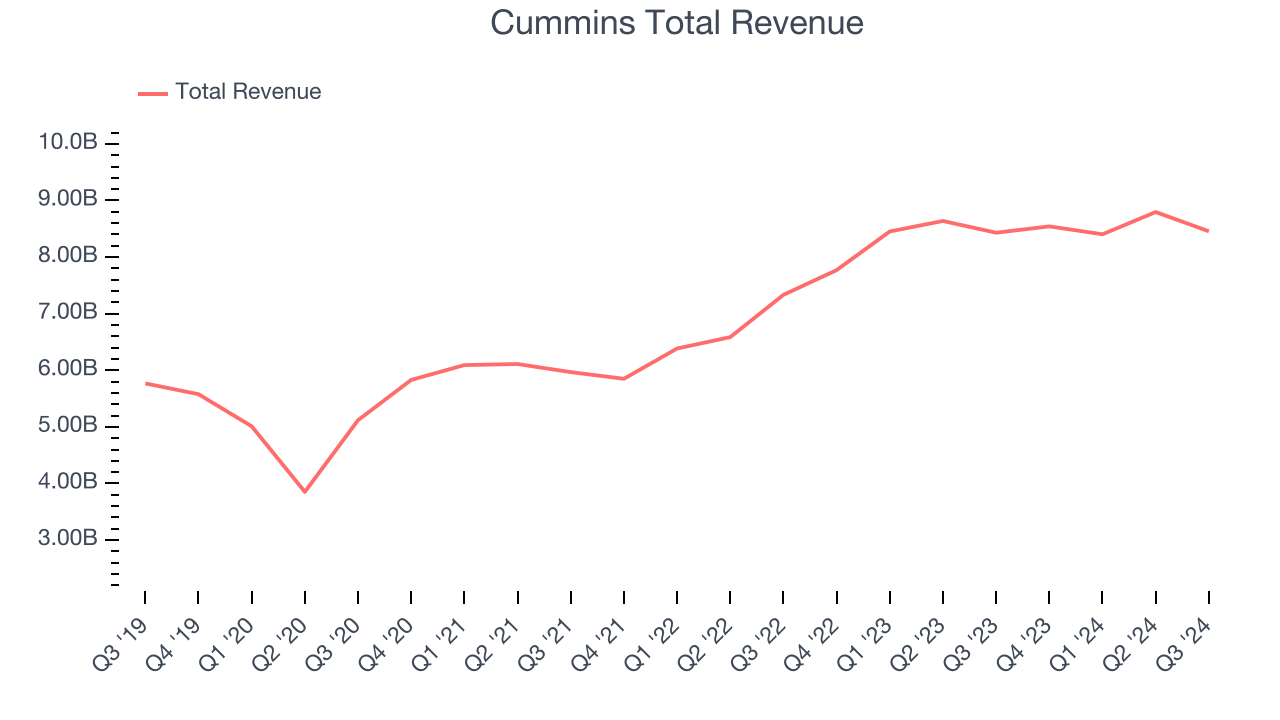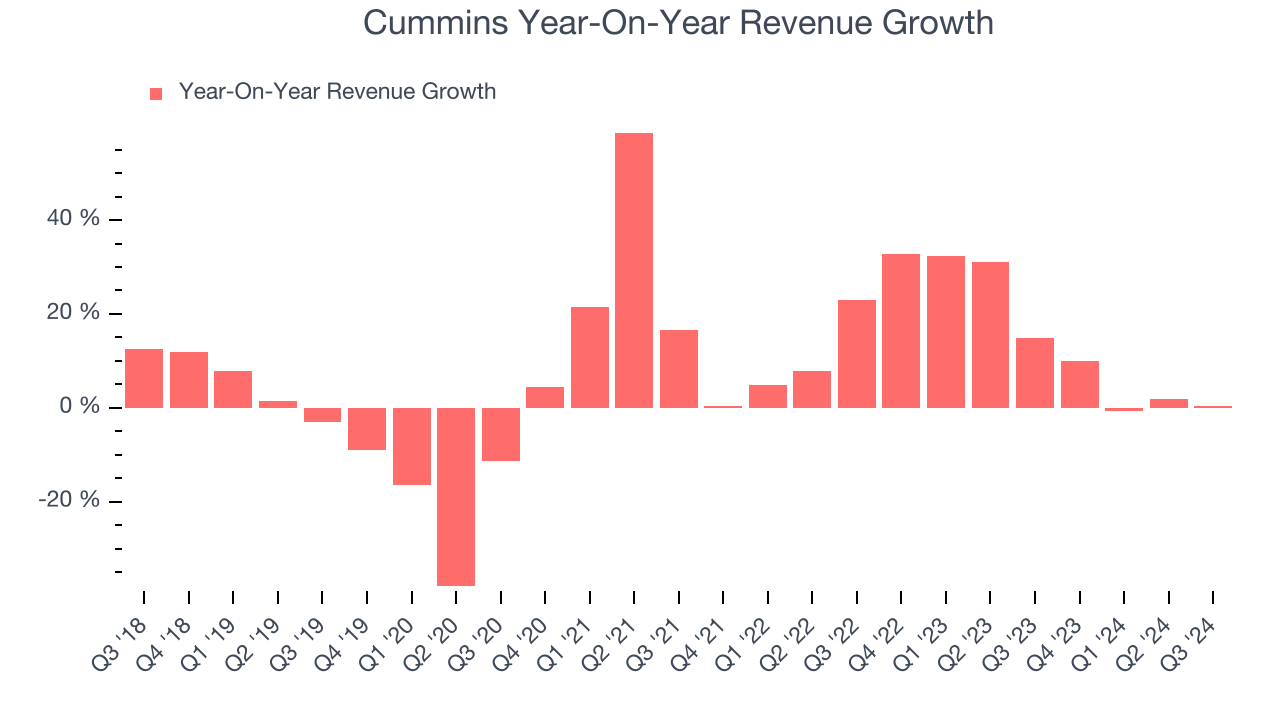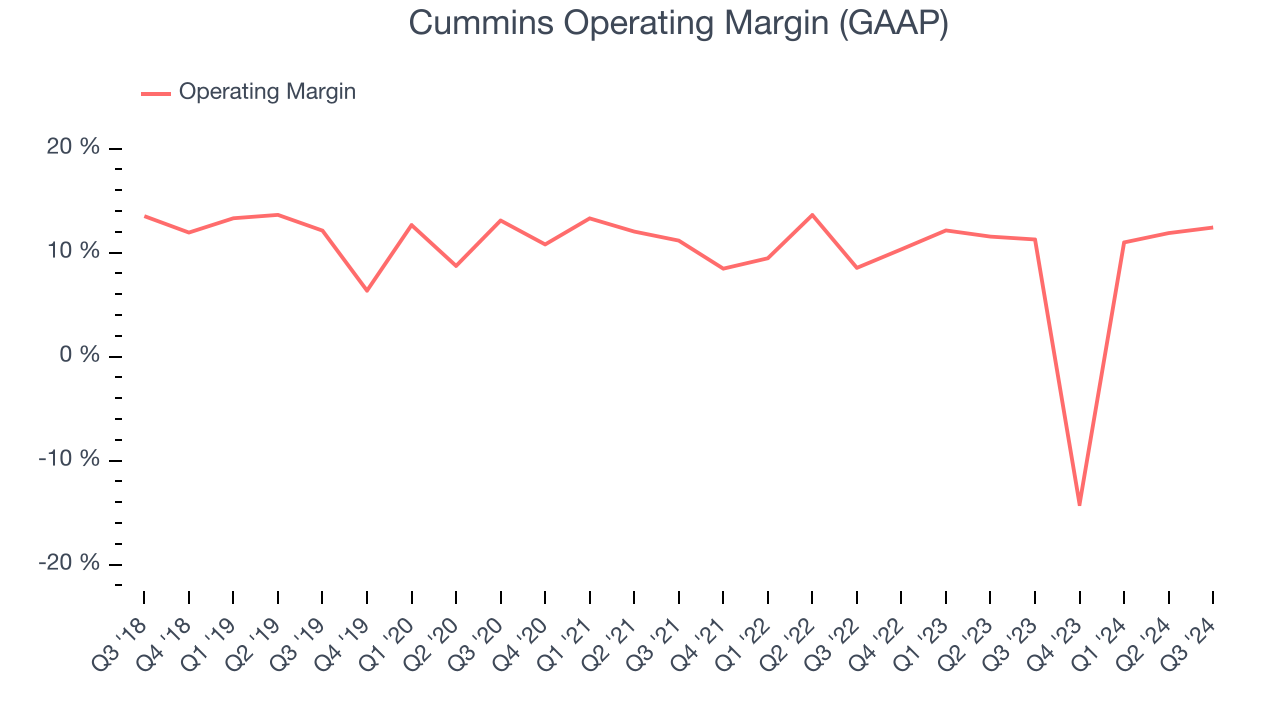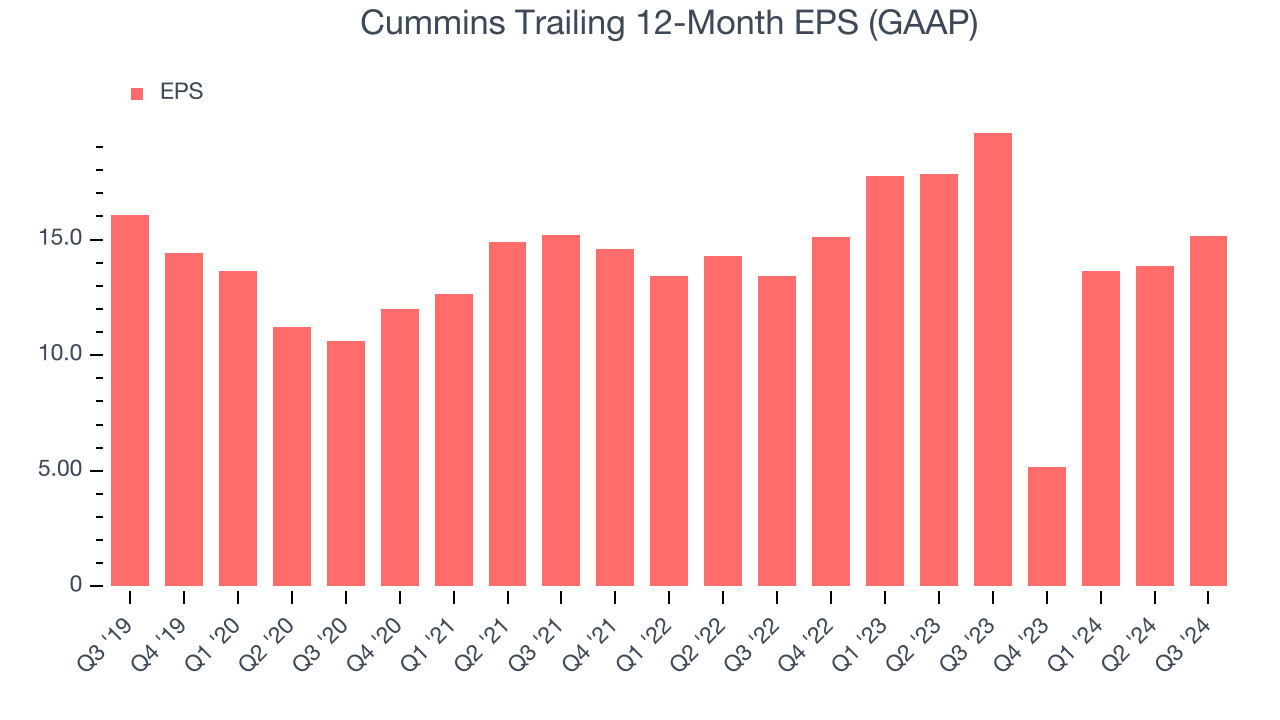
Engine manufacturer Cummins (NYSE:CMI) beat Wall Street’s revenue expectations in Q3 CY2024, but sales were flat year on year at $8.46 billion. Its GAAP profit of $5.86 per share was also 21% above analysts’ consensus estimates.
Is now the time to buy Cummins? Find out by accessing our full research report, it’s free.
Cummins (CMI) Q3 CY2024 Highlights:
- Revenue: $8.46 billion vs analyst estimates of $8.31 billion (1.8% beat)
- EPS: $5.86 vs analyst estimates of $4.84 (21% beat)
- EBITDA: $1.39 billion vs analyst estimates of $1.28 billion (8.6% beat)
- Gross Margin (GAAP): 25.7%, up from 24.6% in the same quarter last year
- Operating Margin: 12.4%, up from 11.3% in the same quarter last year
- EBITDA Margin: 16.4%, up from 14.9% in the same quarter last year
- Free Cash Flow Margin: 4.5%, down from 14.8% in the same quarter last year
- Market Capitalization: $44.63 billion
Company Overview
With more than half of the heavy-duty truck market using its engines at one point, Cummins (NYSE:CMI) offers engines and power systems.
Heavy Transportation Equipment
Heavy transportation equipment companies are investing in automated vehicles that increase efficiencies and connected machinery that collects actionable data. Some are also developing electric vehicles and mobility solutions to address customers’ concerns about carbon emissions, creating new sales opportunities. Additionally, they are increasingly offering automated equipment that increases efficiencies and connected machinery that collects actionable data. On the other hand, heavy transportation equipment companies are at the whim of economic cycles. Interest rates, for example, can greatly impact the construction and transport volumes that drive demand for these companies’ offerings.
Sales Growth
A company’s long-term performance can give signals about its business quality. Even a bad business can shine for one or two quarters, but a top-tier one grows for years. Unfortunately, Cummins’s 7.2% annualized revenue growth over the last five years was mediocre. This shows it couldn’t expand in any major way, a tough starting point for our analysis.

We at StockStory place the most emphasis on long-term growth, but within industrials, a half-decade historical view may miss cycles, industry trends, or a company capitalizing on catalysts such as a new contract win or a successful product line. Cummins’s annualized revenue growth of 14.3% over the last two years is above its five-year trend, suggesting its demand recently accelerated. 
We can better understand the company’s revenue dynamics by analyzing its most important segments, Components and Engine , which are 31.9% and 34.3% of revenue. Over the last two years, Cummins’s Components revenue (axles, brakes, drivelines) averaged 27.6% year-on-year growth while its Engine revenue (diesel and gas-powered engines) averaged 4.8% growth.
This quarter, Cummins’s $8.46 billion of revenue was flat year on year but beat Wall Street’s estimates by 1.8%.
Looking ahead, sell-side analysts expect revenue to remain flat over the next 12 months, a deceleration versus the last two years. This projection doesn't excite us and illustrates the market thinks its products and services will face some demand challenges.
Today’s young investors won’t have read the timeless lessons in Gorilla Game: Picking Winners In High Technology because it was written more than 20 years ago when Microsoft and Apple were first establishing their supremacy. But if we apply the same principles, then enterprise software stocks leveraging their own generative AI capabilities may well be the Gorillas of the future. So, in that spirit, we are excited to present our Special Free Report on a profitable, fast-growing enterprise software stock that is already riding the automation wave and looking to catch the generative AI next.
Operating Margin
Cummins has done a decent job managing its cost base over the last five years. The company has produced an average operating margin of 9.5%, higher than the broader industrials sector.
Looking at the trend in its profitability, Cummins’s annual operating margin decreased by 4.9 percentage points over the last five years. Even though its margin is still high, shareholders will want to see Cummins become more profitable in the future.

This quarter, Cummins generated an operating profit margin of 12.4%, up 1.1 percentage points year on year. The increase was encouraging, and since its operating margin rose more than its gross margin, we can infer it was recently more efficient with expenses such as marketing, R&D, and administrative overhead.
Earnings Per Share
Analyzing revenue trends tells us about a company’s historical growth, but the long-term change in its earnings per share (EPS) points to the profitability of that growth – for example, a company could inflate its sales through excessive spending on advertising and promotions.
Sadly for Cummins, its EPS declined by 1.2% annually over the last five years while its revenue grew by 7.2%. This tells us the company became less profitable on a per-share basis as it expanded.

Diving into the nuances of Cummins’s earnings can give us a better understanding of its performance. As we mentioned earlier, Cummins’s operating margin improved this quarter but declined by 4.9 percentage points over the last five years. This was the most relevant factor (aside from the revenue impact) behind its lower earnings; taxes and interest expenses can also affect EPS but don’t tell us as much about a company’s fundamentals.
Like with revenue, we analyze EPS over a shorter period to see if we are missing a change in the business.
For Cummins, its two-year annual EPS growth of 6.2% was higher than its five-year trend. Accelerating earnings growth is almost always an encouraging data point.In Q3, Cummins reported EPS at $5.86, up from $4.59 in the same quarter last year. This print easily cleared analysts’ estimates, and shareholders should be content with the results. Over the next 12 months, Wall Street expects Cummins’s full-year EPS of $15.14 to grow by 40.3%.
Key Takeaways from Cummins’s Q3 Results
We were impressed by how significantly Cummins blew past analysts’ EPS and EBITDA expectations this quarter. We were also excited that its revenue outperformed Wall Street’s estimates due to strong performance in its Engine division. Overall, we think this was a solid quarter with some key areas of upside. The stock traded up 4.4% to $340 immediately after reporting.
Sure, Cummins had a solid quarter, but if we look at the bigger picture, is this stock a buy? What happened in the latest quarter matters, but not as much as longer-term business quality and valuation, when deciding whether to invest in this stock. We cover that in our actionable full research report which you can read here, it’s free.














